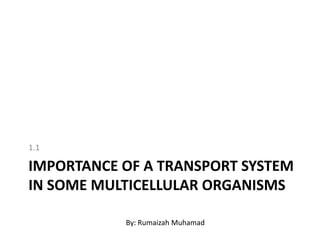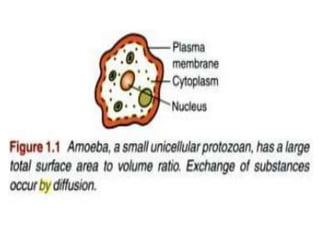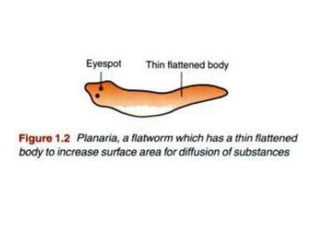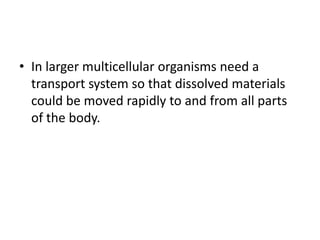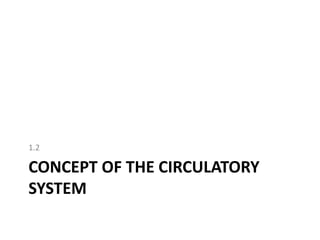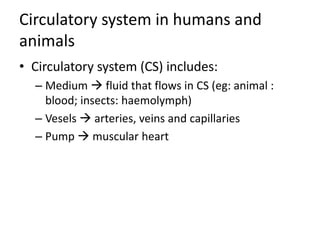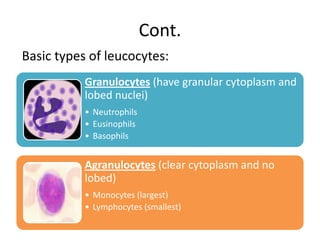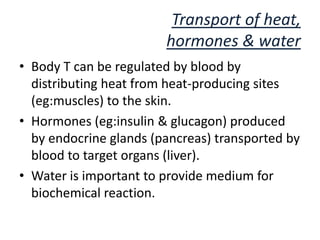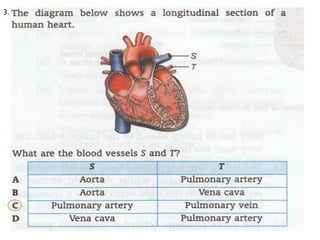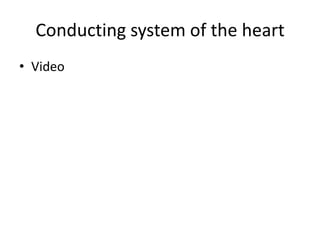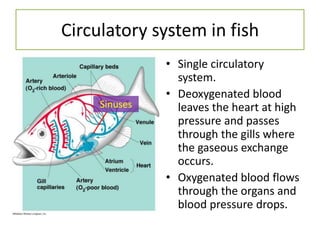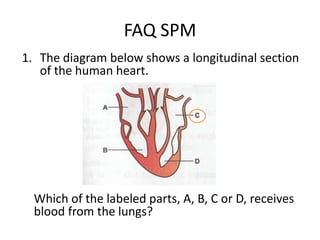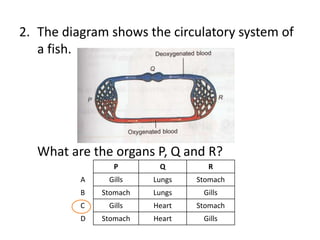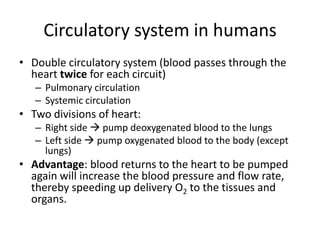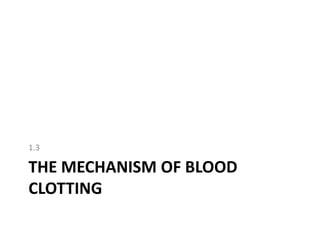Chapter 1: Transport (1.1 - 1.3)
- 1. 1.1 IMPORTANCE OF A TRANSPORT SYSTEM IN SOME MULTICELLULAR ORGANISMS By: Rumaizah Muhamad
- 2. Dimension of cube (cm) 1x1x1 2x2x2 4x4x4 Total surface area of cube (cm2) Volume of cube (cm3) TSA/V ratio Calculate the TSA/V ratio.
- 6. • In larger multicellular organisms need a transport system so that dissolved materials could be moved rapidly to and from all parts of the body.
- 7. 1.2 CONCEPT OF THE CIRCULATORY SYSTEM
- 8. Circulatory system in humans and animals • Circulatory system (CS) includes: – Medium fluid that flows in CS (eg: animal : blood; insects: haemolymph) – Vesels arteries, veins and capillaries – Pump muscular heart
- 11. Erythrocytes
- 12. Erythrocytes • Small, biconcave disc • Have no nucleus • Great quantities of haemoglobin (which contains iron) (Cells become bright red) • Site of production: bone marrow • Life span: 120 days • Site of destruction: liver and spleen (by phagocytes) • Ratio of erythrocytes to leucocytes 1000 : 1 (in normal person)
- 13. Leucocytes (White blood cells) Erythrocytes Leucocytes
- 14. Leucocytes (White blood cells) • Less numerous than eryhtrocytes. • Have nuclei • Do not have haemoglobin • Larger than erythrocytes and do not have fixed shapes. • Site of production : bone marrow • Site of growth and development: thymus gland or lymph nodes
- 15. Cont. Basic types of leucocytes: Granulocytes (have granular cytoplasm and lobed nuclei) • Neutrophils • Eusinophils • Basophils Agranulocytes (clear cytoplasm and no lobed) • Monocytes (largest) • Lymphocytes (smallest)
- 17. Quizzes 1. The neutrophils are _______ A. Phagocytes B. Leucocytes C. Lymphocytes D. Phosphate 2. Which leucocytes that help to control allergic reaction? A. Basophils B. Eosinophils C. Monocytes D. Neutrophils
- 18. 3. Basophils secrete _________ to prevent blood clotting A. Warfarin B. Fibrinogen C. Heparin D. Walfarine 4. Which leucocytes that can move to the body tissues to become phagocytic macrophage? A. Basophils B. Neutrophils C. Eosinophils D. Monocytes
- 19. 5. Some lymphocytes produce _________ to aid in destruction of __________ A. Antibodies, homogens B. Antibodies, pathogens C. Hormones, pathogens D. Enzymes, pathogens
- 20. Platelets • Small, irregularly shaped • F(x) : blood clotting • Life span: 5 -9 days
- 21. Plasma • Pale, yellow liquid • Made up of 90% water & 10% dissolved solutes (gases, minerals, hormones, plasma proteins and excretory wastes) • BOOD SERUM : plasma without fibrinogen (clotting factors).
- 22. Plasma
- 23. Function of blood in transport • Transport oxygen from the lungs to other parts of the body (form 4) • Transport absorbed food materials from the digestive tract to body tissues (form 4) • Transport waste products (form 4) – Eg: carbon dioxide from body tissues to the lungs – Urea to the kidneys • Transport heat, hormones and water
- 24. Transport of heat, hormones & water • Body T can be regulated by blood by distributing heat from heat-producing sites (eg:muscles) to the skin. • Hormones (eg:insulin & glucagon) produced by endocrine glands (pancreas) transported by blood to target organs (liver). • Water is important to provide medium for biochemical reaction.
- 25. Function of haemolymph • Circulating blood-like fluid found in invertebrates with open-circulatory systems • Tubular heart pumps the haemolymph into haemocoel. • Haemolymph – bathes the tissues and internal organ directly. • Nutrients and hormones diffuse from haemolypmh into the cells • Waste products diffuse out from the cells into haemolymph.
- 27. Structure of human blood vessels Blood vessels : tubes that transport blood from one part to another. Arteries Capillaries Veins Transport blood away from Connect arterioles to Transport blood to the the heart venules heart Transport oxygenated Act as the sites for Transport deoxygenated blood (except pulmonary exchange of substances blood (except pulmonary artery) with the cells vein) Thick muscular wall Thinnest wall, one cell Thinner wall thickness No valves except semilunar No valves Valves present to prevent valves at the base of the back flow of blood aorta and pulmonary artery Blood flows in pulses under No pulses. Pressure lower No pulses. Blood flows high pressure than arteries but higher under lower pressure than than veins arteries.
- 30. Artery, vein and capillary
- 31. How blood is propelled through the human circulatory system • Organ responsible to pump the blood : heart
- 32. Structure of the human heart
- 33. How blood is propelled through the human circulatory system • VIDEO
- 34. Lungs Pulmonary veins Vena cava Right ventricle Left atrium Tricuspid Bicuspid valve deO2 blood O2 blood valve Right atrium Left ventricle Aorta Pulmonary artery Whole body
- 35. FAQ SPM 1. The diagram below shows the external view of the human heart. What is the blood vessel labeled W? A. Carotid artery B. Coronary artery C. Subclavian artery D. Systemic artery
- 36. 3.
- 37. The pumping of the heart Sinoatrial node Bundle of His Atrio-ventricular containing node Purkinje tissue Interventricular septum
- 38. Conducting system of the heart • Video
- 39. Contraction of skeletal muscles around veins
- 40. Circulatory system in insects
- 41. 2. Valves ensure the haemolymph flow in one direction 1. When the heart relax, haemolymph re-enters ostia Material exchange occurs here. Haemolymph in haemocoel carry nutrients and waste products
- 42. Circulatory system in fish • Single circulatory system. • Deoxygenated blood Sinuses leaves the heart at high pressure and passes through the gills where the gaseous exchange occurs. • Oxygenated blood flows through the organs and blood pressure drops.
- 43. Circulatory system in amphibians (eg:frogs) • Double circulatory system: – Pulmonary circulation – Systemic circulation • Have three-chambered heart (2 atria & 1 ventricle) • Mixing of oxygenated and deoxygenated blood in ventricle. The mixed blood enters the systemic circulation.
- 46. FAQ SPM 1. The diagram below shows a longitudinal section of the human heart. Which of the labeled parts, A, B, C or D, receives blood from the lungs?
- 47. 2. The diagram shows the circulatory system of a fish. What are the organs P, Q and R? P Q R A Gills Lungs Stomach B Stomach Lungs Gills C Gills Heart Stomach D Stomach Heart Gills
- 48. Circulatory system in humans • Double circulatory system (blood passes through the heart twice for each circuit) – Pulmonary circulation – Systemic circulation • Two divisions of heart: – Right side pump deoxygenated blood to the lungs – Left side pump oxygenated blood to the body (except lungs) • Advantage: blood returns to the heart to be pumped again will increase the blood pressure and flow rate, thereby speeding up delivery O2 to the tissues and organs.
- 49. Assignment 1.3 1. Draw and label a longitudinal section of human heart. 2. List the functions of the different types of leucocytes.
- 50. 1.3 THE MECHANISM OF BLOOD CLOTTING
- 51. The necessities of blood clotting • To prevent: – serious blood loss – the entry of microorganisms and foreign particles into the blood • To maintain: – normal blood pressure – circulation of blood in a a closed circulatory system
- 52. The mechanism of blood clotting
- 54. VIDEO
- 55. FAQ SPM 1. The conversion of the soluble fibrinogen present in blood plasma into the insoluble fibrin is by A. calcium ion B. thrombin C. thromboplastins D. vitamin K
- 56. FAQ SPM 2. Fibrinogen, fibrin, thrombin and prothrombin are necessary for blood clotting. Which of the following is the correct sequence for the involvement of these four substances during blood clotting? A. Prothrombin, thrombin, fibrinogen, fibrin B. Thrombin, prothrombin, fibrin, fibrinogen C. Fibrinogen, fibrin, prothrombin, thrombin D. Fibrin, fibrinogen, thrombin, prothrombin
- 57. Impaired blood clotting mechanisms in human The consequences
- 60. Assignment 1.4 1. List the advantages of blood clotting at the site of damaged blood vessels. 2. Draw a schematic diagram to illustrate the mechanism of blood clotting. 3. What would happen if a blood clot forms a) In the brain b) In the coronary artery
Editor's Notes
- Haemocoel – fluid-filled spaces
- Heomocel : body cavityHaemolymph : insect’s blood
- 1. Single circulatory system : blood flows through the heart only once for each complete circuit.2. Sinuses: collect deoxygenated blood before entering the atrium.

